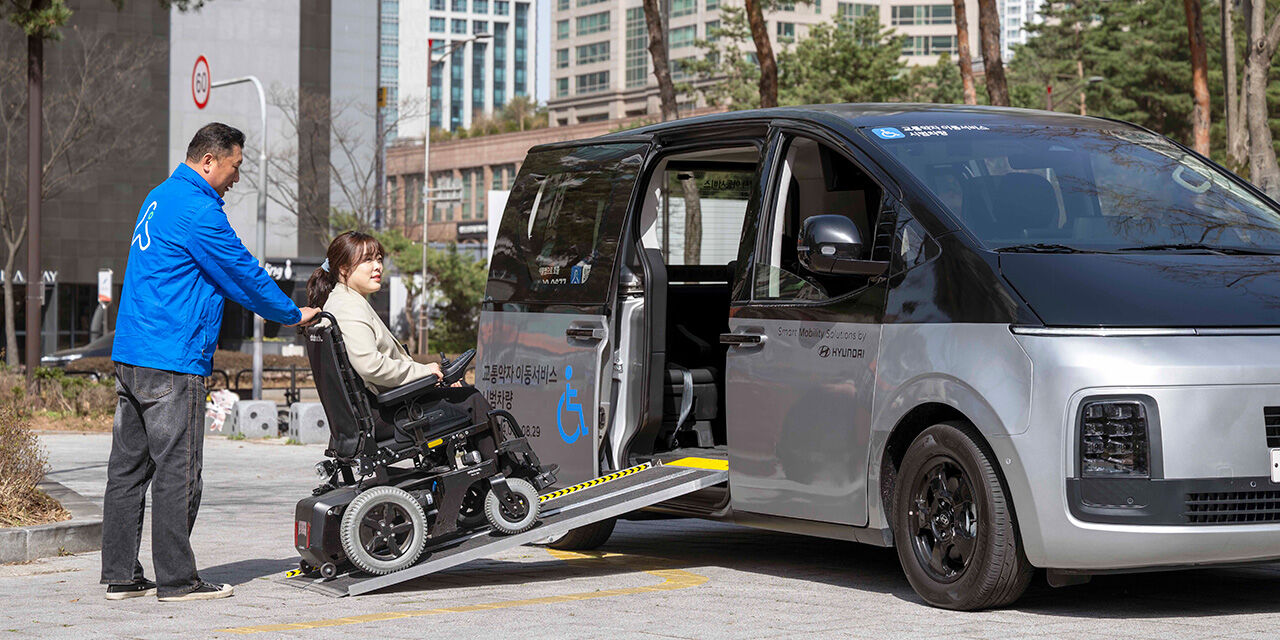Hyundai Motor Advances Accessible Transportation with Innovative Mobility Solutions – Hyundai

Shucle: Hyundai Motor’s Demand-Responsive Mobility Service

Shucle, Hyundai Motor’s demand-responsive mobility service, leverages artificial intelligence to provide efficient and flexible transportation solutions. By dynamically adjusting routes in real-time based on user requests, it enables seamless ride-sharing and ensures a more accessible and accommodating travel experience for passengers.
Introduction of Voucher System
A key feature of the initiative is the introduction of a voucher system available to existing voucher taxi users, allowing them to ride up to twice a day free of charge. This system streamlines the process for users, who can now issue an electronic voucher directly through the Shucle app and begin using it immediately, eliminating the previous need to contact a mobility support center for authentication.
Enhancing Universal Accessibility
The demonstration highlights vehicles designed for universal accessibility, enhancing convenience and inclusivity for all passengers. The improved design allows for side-door boarding, allowing passengers with mobility support to travel comfortably alongside up to two companions. This improves upon traditional solutions that required rear boarding and isolated seating, which could lead to discomfort and social disconnection.
For passengers with vision or hearing loss, the vehicles are equipped with an accessibility-focused interface that includes high contrast mode and a tablet for seamless communication with the driver. The tablet, installed in the rear seat, allows passengers to easily send text messages, ensuring a more convenient and accommodating travel experience.
Commitment to Sustainable Development Goals
Hyundai Motor has been actively conducting research and pilot projects to enhance mobility for people with accessibility needs, including the Enable LA project in 2021. Building on the insights and data gathered from these initiatives, Hyundai Motor will continue refining its mobility solutions and services for real-world implementation.
Using insights gained from these initiatives, Hyundai Motor is committed to continuously refining its devices and services for broader implementation, aiming to foster freedom of movement for all in a more inclusive, accessible world.
SDGs, Targets, and Indicators
| SDGs | Targets | Indicators |
|---|---|---|
| SDG 9: Industry, Innovation, and Infrastructure | 9.1: Develop quality, reliable, sustainable, and resilient infrastructure | – Introduction of a voucher system for existing voucher taxi users – Use of artificial intelligence to dynamically adjust routes in real-time |
| SDG 10: Reduced Inequalities | 10.2: Empower and promote the social, economic, and political inclusion of all | – Vehicles designed for universal accessibility, allowing side-door boarding – Accessibility-focused interface for passengers with vision or hearing loss |
| SDG 11: Sustainable Cities and Communities | 11.2: Provide access to safe, affordable, accessible, and sustainable transport systems for all | – Vehicles designed for universal accessibility, allowing side-door boarding – Introduction of a voucher system for existing voucher taxi users |
1. Which SDGs are addressed or connected to the issues highlighted in the article?
The issues highlighted in the article are connected to SDG 9: Industry, Innovation, and Infrastructure, SDG 10: Reduced Inequalities, and SDG 11: Sustainable Cities and Communities.
2. What specific targets under those SDGs can be identified based on the article’s content?
Based on the article’s content, the specific targets that can be identified are:
– Target 9.1: Develop quality, reliable, sustainable, and resilient infrastructure.
– Target 10.2: Empower and promote the social, economic, and political inclusion of all.
– Target 11.2: Provide access to safe, affordable, accessible, and sustainable transport systems for all.
3. Are there any indicators mentioned or implied in the article that can be used to measure progress towards the identified targets?
Yes, there are indicators mentioned or implied in the article that can be used to measure progress towards the identified targets. These indicators include:
– Introduction of a voucher system for existing voucher taxi users: This indicates progress towards providing affordable and accessible transport systems (Target 11.2).
– Use of artificial intelligence to dynamically adjust routes in real-time: This indicates progress towards developing sustainable and resilient infrastructure (Target 9.1).
– Vehicles designed for universal accessibility, allowing side-door boarding: This indicates progress towards promoting social inclusion and accessibility (Target 10.2 and Target 11.2).
– Accessibility-focused interface for passengers with vision or hearing loss: This indicates progress towards promoting social inclusion and accessibility (Target 10.2).
By analyzing these indicators, progress towards the identified targets can be measured.
4. SDGs, Targets, and Indicators
| SDGs | Targets | Indicators |
|---|---|---|
| SDG 9: Industry, Innovation, and Infrastructure | 9.1: Develop quality, reliable, sustainable, and resilient infrastructure | – Introduction of a voucher system for existing voucher taxi users – Use of artificial intelligence to dynamically adjust routes in real-time |
| SDG 10: Reduced Inequalities | 10.2: Empower and promote the social, economic, and political inclusion of all | – Vehicles designed for universal accessibility, allowing side-door boarding – Accessibility-focused interface for passengers with vision or hearing loss |
| SDG 11: Sustainable Cities and Communities | 11.2: Provide access to safe, affordable, accessible, and sustainable transport systems for all | – Vehicles designed for universal accessibility, allowing side-door boarding – Introduction of a voucher system for existing voucher taxi users |
Source: hyundai.com








